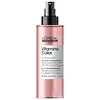What's inside
What's inside
 Key Ingredients
Key Ingredients

 Benefits
Benefits

 Concerns
Concerns

 Ingredients Side-by-side
Ingredients Side-by-side

Water
Skin ConditioningCocos Nucifera Oil
MaskingAmodimethicone
Polyquaternium-37
Phenoxyethanol
PreservativePropylene Glycol Dicaprylate/Dicaprate
EmollientTocopherol
AntioxidantSodium Hydroxide
BufferingDimethicone PEG-7 Phosphate
CleansingPPG-1 Trideceth-6
Skin ConditioningTrideceth-6
EmulsifyingBehentrimonium Chloride
PreservativeXylose
HumectantLactic Acid
BufferingEthylhexylglycerin
Skin ConditioningLinalool
PerfumingSorbitan Oleate
EmulsifyingIsopropyl Alcohol
SolventCetrimonium Chloride
AntimicrobialHydrolyzed Vegetable Protein Pg-Propyl Silanetriol
Skin ConditioningResveratrol
AntioxidantBenzyl Alcohol
PerfumingLimonene
PerfumingCoumarin
PerfumingPotassium Sorbate
PreservativeParfum
MaskingWater, Cocos Nucifera Oil, Amodimethicone, Polyquaternium-37, Phenoxyethanol, Propylene Glycol Dicaprylate/Dicaprate, Tocopherol, Sodium Hydroxide, Dimethicone PEG-7 Phosphate, PPG-1 Trideceth-6, Trideceth-6, Behentrimonium Chloride, Xylose, Lactic Acid, Ethylhexylglycerin, Linalool, Sorbitan Oleate, Isopropyl Alcohol, Cetrimonium Chloride, Hydrolyzed Vegetable Protein Pg-Propyl Silanetriol, Resveratrol, Benzyl Alcohol, Limonene, Coumarin, Potassium Sorbate, Parfum
Water
Skin ConditioningCetearyl Alcohol
EmollientPolysorbate 20
EmulsifyingBehentrimonium Chloride
PreservativeParfum
MaskingCetyl Esters
EmollientOrbignya Oleifera Seed Oil
EmollientAmodimethicone
Sodium Benzoate
MaskingIsopropyl Alcohol
SolventCitric Acid
BufferingPEG/PPG/Polybutylene Glycol-8/5/3 Glycerin
HumectantPentaclethra Macroloba Seed Oil
EmollientHexyl Cinnamal
PerfumingBHT
AntioxidantTrideceth-6
EmulsifyingChlorhexidine Dihydrochloride
AntimicrobialAlpha-Isomethyl Ionone
PerfumingXylose
HumectantEthylhexyl Methoxycinnamate
UV AbsorberCetrimonium Chloride
AntimicrobialWater, Cetearyl Alcohol, Polysorbate 20, Behentrimonium Chloride, Parfum, Cetyl Esters, Orbignya Oleifera Seed Oil, Amodimethicone, Sodium Benzoate, Isopropyl Alcohol, Citric Acid, PEG/PPG/Polybutylene Glycol-8/5/3 Glycerin, Pentaclethra Macroloba Seed Oil, Hexyl Cinnamal, BHT, Trideceth-6, Chlorhexidine Dihydrochloride, Alpha-Isomethyl Ionone, Xylose, Ethylhexyl Methoxycinnamate, Cetrimonium Chloride
Ingredients Explained
These ingredients are found in both products.
Ingredients higher up in an ingredient list are typically present in a larger amount.
This water-soluble silicone is used for its hydrating and softening properties. It is used to add a silky feel to skincare products and has great benefits for haircare.
In haircare, this ingredient:
- Adds shine
- Protects color
- Offers thermal protection
- Boosts hair strength
- Does not build up as easily
This ingredient is a preservative and often used for it's anti-static properties. You'll most likely see this ingredient in hair conditioners.
It does not cause irritation or sensitization in leave-on products at 1-5%.
This ingredient is a preservative, antimicrobial, and emulsifier. It is often used in cosmetics for its ability to cleanse, condition, and reduce static.
Cetrimonium chloride is a quaternary ammonium salt, meaning it has a water-soluble structure.
Isopropyl Alcohol is more commonly known as rubbing alcohol. It is most commonly used as a solvent, meaning it helps other ingredients dissolve.
This ingredient is an astringent alcohol. Astringent alcohols may also irritate skin as they high amounts may strip away your skin's natural oils.
Other types of astringent alcohols include:
According to the National Rosacea Society based in the US, you should be mindful of products with these alcohols in the top half of ingredients.
Any type of sanitizing product will have high amounts of alcohol to help kill bacteria and viruses.
Learn more about Isopropyl AlcoholParfum is a catch-all term for an ingredient or more that is used to give a scent to products.
Also called "fragrance", this ingredient can be a blend of hundreds of chemicals or plant oils. This means every product with "fragrance" or "parfum" in the ingredients list is a different mixture.
For instance, Habanolide is a proprietary trade name for a specific aroma chemical. When used as a fragrance ingredient in cosmetics, most aroma chemicals fall under the broad labeling category of “FRAGRANCE” or “PARFUM” according to EU and US regulations.
The term 'parfum' or 'fragrance' is not regulated in many countries. In many cases, it is up to the brand to define this term.
For instance, many brands choose to label themselves as "fragrance-free" because they are not using synthetic fragrances. However, their products may still contain ingredients such as essential oils that are considered a fragrance by INCI standards.
One example is Calendula flower extract. Calendula is an essential oil that still imparts a scent or 'fragrance'.
Depending on the blend, the ingredients in the mixture can cause allergies and sensitivities on the skin. Some ingredients that are known EU allergens include linalool and citronellol.
Parfum can also be used to mask or cover an unpleasant scent.
The bottom line is: not all fragrances/parfum/ingredients are created equally. If you are worried about fragrances, we recommend taking a closer look at an ingredient. And of course, we always recommend speaking with a professional.
Learn more about ParfumWe don't have a description for Trideceth-6 yet.
Water. It's the most common cosmetic ingredient of all. You'll usually see it at the top of ingredient lists, meaning that it makes up the largest part of the product.
So why is it so popular? Water most often acts as a solvent - this means that it helps dissolve other ingredients into the formulation.
You'll also recognize water as that liquid we all need to stay alive. If you see this, drink a glass of water. Stay hydrated!
Learn more about WaterWe don't have a description for Xylose yet.